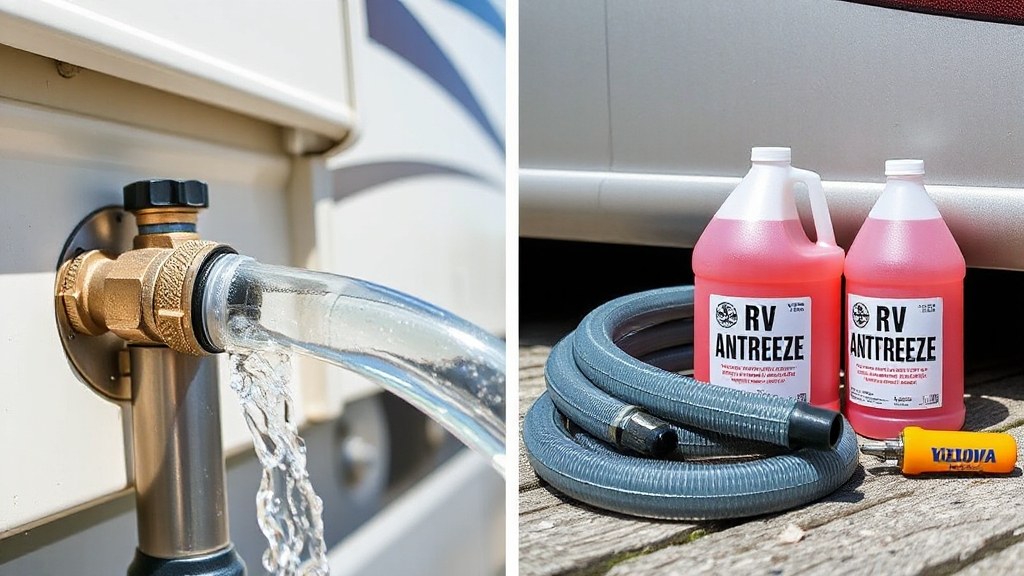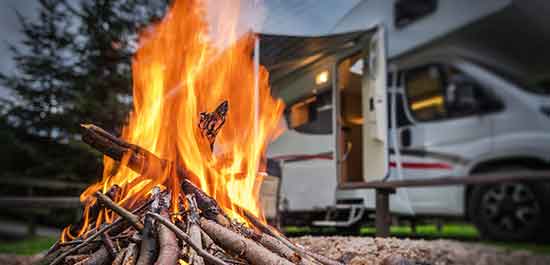Last Updated on May 31, 2025
You can protect your RV plumbing by either blowing out the water lines or using antifreeze. Blowing out lines quickly removes water, avoids chemical use, and prevents damage when done with careful pressure control.
Antifreeze offers thorough freeze protection, preserves seals, and reaches hard-to-drain spots but adds seasonal costs and requires proper disposal. Your choice depends on climate and maintenance priorities.
Understanding these trade-offs will help you optimize winterizing your RV’s water system effectively.
- Blowout plug adapter fitting to winterize recreational vehicles (RV), motorhome, boat, watercraft,…
- Screws into RV’s city water inlet or standard garden hose. Quick-connect attaches to air compressor….
- Its short and stubby design allows access to tight spaces. Its solid one-piece construction…
This antifreeze is added to RV and marine plumbing systems to stop water pipes from freezing in very cold temperatures. It is nontoxic and formulated to not damage plumbing lines the way other types of antifreeze would.
Key Takeaways
- Blowing out RV water lines removes residual water, preventing freeze damage without chemicals, but requires careful pressure control to avoid plumbing damage.
- Using antifreeze protects seals, lubricates plumbing, and prevents freezing in hard-to-drain areas, providing comprehensive freeze protection in severe climates.
- Blowing out lines has lower long-term costs with a one-time air compressor purchase, while antifreeze involves recurring seasonal expenses and disposal considerations.
- Combining both methods enhances freeze protection but increases upfront and maintenance costs; method choice depends on climate severity and storage duration.
- Dewinterizing after antifreeze use requires flushing and sanitizing, while blowing out lines allows quicker spring start-up with minimal chemical handling.
Benefits of Blowing Out RV Water Lines
Although some antifreeze may still be necessary in traps and appliances, blowing out your RV’s water lines with compressed air eliminates the need for most antifreeze, reducing both costs and environmental impact while preserving your plumbing system.
By using controlled air pressure, you effectively remove residual water, preventing freeze damage without introducing chemicals like propylene glycol. This method markedly cuts annual antifreeze expenses and avoids the odor or taste antifreeze can leave behind.
Maintain the air pressure at safe levels, typically less than 40 psi, to prevent damage to your pipes and connections. Regular maintenance, similar to how G rated trailer tires require proper pressure checks for safety, ensures your water lines remain intact and damage-free.
Additionally, drying the system with air speeds up spring start-up since you won’t need to flush or sanitize antifreeze residues. Proper technique requires blowing out every line carefully to avoid damage, but when done correctly, it minimizes corrosion risks and burst pipes.
Advantages of Using Antifreeze in RV Plumbing
When you use antifreeze in your RV plumbing, you guarantee maximum freeze protection by lowering the freezing point throughout the entire system. This helps prevent pipe bursts and damage during extreme cold temperatures, ensuring system reliability in winter conditions.
It’s formulated to be safe for freshwater use, eliminating risks of contamination and health hazards. Using products that meet NSF/ANSI 61 standards further ensures safety by preventing harmful chemical exposure.
Plus, antifreeze lubricates seals in your plumbing, maintaining their integrity and preventing leaks during cold-weather storage. Use RV-specific pink antifreeze to avoid the toxicity risks associated with vehicle antifreeze, which can cause kidney failure if ingested by animals RV-specific antifreeze.
Maximum Freeze Protection
Because RV antifreeze lowers the freezing point of residual water in your plumbing lines, it offers superior protection against freeze damage compared to simply blowing out the system with air.
Specialized formulas, like Recochem’s Plumbing Antifreeze MAX, protect down to -100ºF undiluted, ensuring pipes, fittings, and tanks remain intact. This method also reduces the risk of corrosion by using non-toxic and biodegradable ingredients found in many RV antifreeze products.
Unlike air, antifreeze reaches areas prone to trapped water, such as P-traps and water heaters, coating internal surfaces to prevent ice formation and potential ruptures. Use full-strength antifreeze without diluting it with water to maintain optimal freeze protection.
You introduce antifreeze through the water pump and T-valve setup, bypassing the water heater to maximize efficiency. This method requires minimal volume, typically 2-4 gallons, and replaces residual water entirely with a freeze-resistant solution, delivering extensive, reliable freeze protection during cold storage periods.
Regular use of antifreeze also supports long-term maintenance benefits by preventing damage caused by freezing and thawing cycles.
Safe Freshwater Use
If you want to maintain your RV’s freshwater system safely during freezing conditions, using RV antifreeze offers distinct advantages. It’s specifically formulated with nontoxic ingredients like propylene glycol, ensuring the water system remains safe and potable.
This nontoxic solution lowers the freezing point of residual water, protecting pipes and fittings from freeze damage. Many RV owners prefer it over household bleach, which can leave harmful residues affecting water taste and safety.
Antifreeze also reaches hard-to-drain areas such as p-traps and water heaters, preventing freeze damage that blowing out lines might miss. This comprehensive approach helps avoid contamination signs like strange odors or cloudy water that indicate the need for thorough cleaning.
Here are three key benefits of using antifreeze in your RV plumbing:
- Comprehensive Protection: Safeguards all plumbing components, including those inaccessible by compressed air.
- Reduced Maintenance: Eliminates the need for repeated flushing when moving between climates.
- Eco-Friendly and Safe: Designed for safe disposal and compliant with environmental regulations, using biodegradable and non-toxic ingredients.
Plumbing Seal Lubrication
Although many RV owners focus on draining water lines to prevent freeze damage, applying antifreeze plays a crucial role in maintaining plumbing seal integrity during cold storage. Antifreeze keeps seals flexible, lubricated, and protected from freeze-thaw cycles that cause cracking and leaks.
Propylene glycol-based antifreeze is preferred for this purpose as it is non-toxic and safe for potable water systems, ensuring both safety and effectiveness. Additionally, using products with hydrophobic properties can help protect seals by repelling moisture that contributes to freeze damage.
| Benefit | Explanation |
|---|---|
| Seal Flexibility | Prevents drying and hardening of rubber/plastic seals |
| Essential Protection | Reaches hard-to-drain traps and joints |
| Lubrication | Reduces friction, wear, and corrosion |
| Freeze Resistance | Maintains seal integrity below -50°C |
| System Readiness | Keeps seals ready for immediate use after storage |
Cost Comparison Between Blowing Out Lines and Antifreeze
You’ll face an initial cost when buying an air compressor to blow out your RV’s water lines, but long-term expenses are minimal compared to repeatedly purchasing antifreeze each season.
Maintenance and repair costs for the compressor are low, whereas antifreeze requires ongoing purchases and disposal fees. Evaluating these factors helps determine the most cost-effective winterization method for your RV.
Additionally, many RVers find that annual antifreeze purchases add up quickly, making air blowing a more economical choice over time. Considering durability and material considerations of winterization methods also impacts overall maintenance cost and effectiveness.
Initial and Long-Term Costs
When comparing initial and long-term costs between blowing out RV water lines and using antifreeze, you need to contemplate equipment expenses, maintenance, and recurring material costs.
Blowing out lines requires an air compressor, a one-time investment if you don’t already own one, which can last many years with proper upkeep. Proper maintenance can significantly extend the life of your equipment and reduce overall expenses.
Consider these factors:
- Initial Investment: Air compressor versus yearly antifreeze and accessories.
- Recurring Costs: Minimal for blowing out lines; antifreeze must be replenished annually.
- Longevity: Compressor durability contrasts with consumable antifreeze, affecting cumulative spending.
Many RV owners prefer combining both methods for greater security against freeze damage despite the increased effort and cost. Additionally, selecting the right protection method can be influenced by the temperature performance range typical to your environment.
Maintenance and Repair Expenses
Beyond initial investments and ongoing material costs, maintenance and repair expenses considerably influence the overall cost-effectiveness of blowing out RV water lines versus using antifreeze.
Choosing the right method also depends on the specific design and materials of your RV’s plumbing, which can affect durability and risk of damage from winterization.
When you blow out lines, you avoid recurring antifreeze purchases, but you must factor in potential repair costs from valve or fitting damage caused by improper air pressure.
Proper technique minimizes repair risk, making your choice dependent on balancing upfront equipment costs against ongoing material and service expenses. Additionally, drain freshwater tanks and water lines before applying either method to ensure maximum protection against freeze damage.
Steps and Considerations for De-Winterizing RV Water Systems
Before restoring your RV’s water system to regular use, thoroughly inspect and prepare all plumbing components to prevent damage or contamination.
Start by airing out your RV and opening all low point drains until water runs clear. Ensure the water heater bypass is disabled and the anode rod or tank plug is installed. During this inspection, visually check plumbing connections around the hot water tank for leaks or damage.
Using a generator with clean power output can help maintain electrical components during this process. Thoroughly inspect and prepare your RV’s plumbing before restoring water system use to prevent damage or contamination.
Follow these steps for effective de-winterizing:
- Connect city water with a pressure regulator and filter, then flush all faucets—cold then hot—until clear water flows.
- Sanitize by adding a bleach solution to the fresh water tank, circulating it through all faucets, and letting it sit for several hours.
- Drain and refill the water heater, purging air from hot water lines before activating the heater and checking for leaks.
Environmental and Safety Factors to Consider
Completing the de-winterizing steps sets the stage for evaluating environmental and safety factors that influence your choice of winterization method.
When using antifreeze, select propylene glycol-based RV antifreeze to minimize toxicity and protect plumbing systems. Handle antifreeze with gloves and ensure proper disposal at hazardous waste sites to prevent soil, water contamination and harm to wildlife.
Avoid ethylene glycol, which poses greater environmental and health risks. Choosing biodegradable products can further reduce environmental impact during winterization.
Blowing out lines uses compressed air, conserving water and eliminating chemical waste, but requires caution: inspect your system for leaks, use appropriate safety gear, and verify pressure limits to avoid damage.
Ecocampor’s commitment to quality assurance ensures that RV plumbing systems undergo thorough inspections to maintain durability and prevent leaks throughout the winterization process.
Although energy consumption increases slightly, blowing out lines reduces environmental impact and waste disposal concerns. Assess these factors carefully to maintain safety and environmental integrity during winterization.
Choosing the Right Winterizing Method for Your Climate
When selecting a winterizing method, you must consider your local climate’s temperature patterns and freeze risk. Choosing the right winterizing method depends on your area’s freeze risk and temperature trends.
In mild climates where temperatures rarely drop below freezing, blowing out water lines alone typically suffices. For transitional zones with occasional freezes, combine blowing out lines with RV antifreeze for added protection.
In harsh winter climates, such as the Upper Midwest or Northeast, thorough winterization requires bypassing the water heater, blowing out lines, and filling the system with antifreeze. It is important to drain water heater and lines properly before adding antifreeze to avoid damage.
- Mild climates: Blow out water lines; minimal risk of freeze damage.
- Moderate climates: Blow out lines + antifreeze to prevent freeze damage from cold snaps.
- Severe climates: Full winterization with antifreeze, line blowout, and heater bypass to protect against prolonged freezes.
Frequently Asked Questions
Can I Use Both Blowing Out and Antifreeze Methods Together?
Yes, you can combine blowing out and antifreeze methods for winterizing your RV water system. Start by thoroughly blowing out all water lines with compressed air to remove as much water as possible. Then, pump non-toxic RV antifreeze through the system to coat internal surfaces.
Finally, blow out the antifreeze again to minimize residue, reducing cleanup and antifreeze taste. This hybrid approach offers enhanced freeze protection but requires careful attention to detail.
How Often Should I Winterize My RV Water System?
You should winterize your RV water system every time you expect freezing temperatures and won’t be using the RV. Typically, this means performing winterization at the end of each camping season. In colder climates, you may need to winterize more frequently or before unexpected cold snaps.
Regular checks and maintenance guarantee your system stays protected year-round, preventing freeze damage and costly repairs. Always follow manufacturer guidelines for timing and procedures.
What Type of Air Compressor Is Best for Blowing Out Water Lines?
You’ll want an air compressor with at least 30-50 PSI output, regulated to prevent plumbing damage. A 3-6 gallon oil-less compressor with a 100-150 PSI max rating and a CFM around 0.6-2.3 is ideal.
For example, the Viair 400P-RV offers a 100% duty cycle at 150 PSI, ensuring continuous airflow without overheating. Always use a regulator and open valves fully for effective water line blowout.
Are There Any Risks of Damaging Pipes When Blowing Out Water Lines?
Yes, you risk damaging pipes if you use air pressure that’s too high. Avoid exceeding 50 psi; ideally, keep it around 35 psi to protect seals and valves. Always open faucets during the process to prevent pressure buildup, which can cause leaks or burst pipes.
Use a compressor designed for RV water systems, follow manufacturer guidelines closely, and monitor for water mist to guarantee thorough water evacuation without causing damage.
The Final Flush: Making the Smart Choice for Your RV’s Plumbing
When winterizing your RV, choosing between blowing out water lines and using antifreeze boils down to your climate and convenience. Blowing out lines is like giving your system a fresh breath of air, avoiding chemical residue.
Antifreeze offers peace of mind in harsher conditions but requires careful flushing. Weigh costs, safety, and environmental impact before deciding. Follow precise steps to de-winterize properly and keep your plumbing running smoothly all season long.
- Brass Material: Brass, for your health and safety, certified to contain less than 0.25% lead. Hose…
- Max Pressure rating: 300 PSI. Temperature ranging: -22℉ ~ +250℉. Hose Pipe Length: 12 inches…
- Adapter to easily winterize underground irrigation sprinkler systems, outdoor pipes, water lines,…
Last update on 2025-12-10 / Affiliate links / Images from Amazon Product Advertising API







